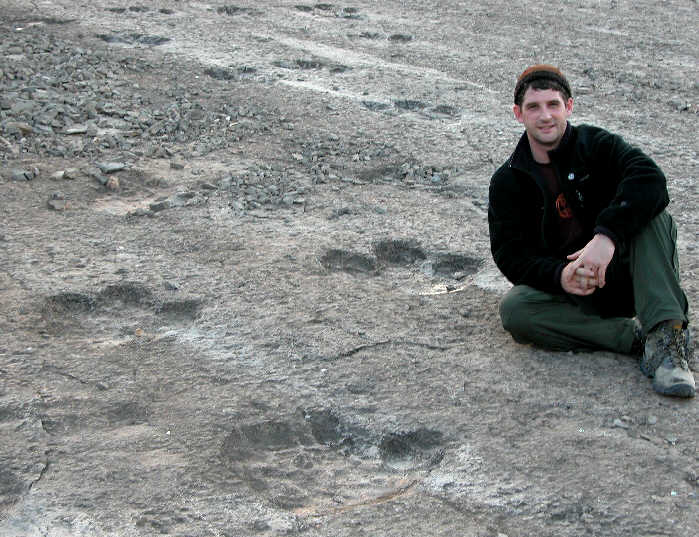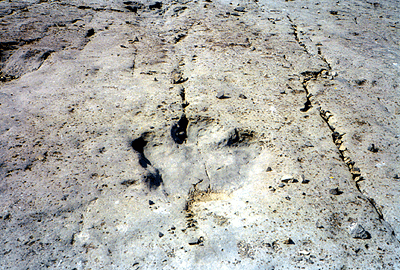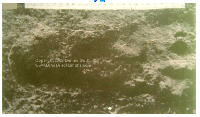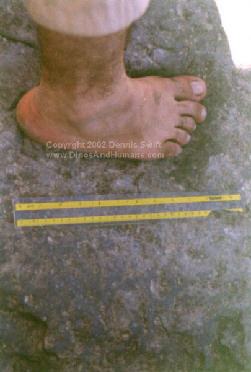

Part of Kuban's Paluxy web site
Since the early 1980's unconfirmed reports have circulated that human footprints occur alongside dinosaur tracks in Turkmenistan (formerly part of the U.S.S.R) in central Asia, near the Usbekistan border. One report appeared in the English version of Moscow News in 1983 (No. 24, p. 10). However, I have not been able to locate the original report, or any photographs that might have accompanied it. The article quoted Professor Kurban Amanniyazov, leader of an expedition to the site, as commenting that there were not enough grounds to state with certainty that the prints were human, noting that the site contained "imprints resembling human footprints" but that they had "to date have failed to determine, with any scientific veracity, whom they belong to."
A 1996 Creation magazine article by Russian geophysicist Sergei Golovin, reproduced as an AIG website article, reported that the 31 January 1995 edition of the Russian newspaper Komsomolskaya Pravda stated, "Human footprints lie alongside thousands of dinosaur prints on a Turkmenian plateau." The author of the article, journalist Alexander Bushev, reportedly traveled to the tracksite near the village of Khodja-Pil Ata in Turkmenistan, and had seen the fossilized prints of dinosaurs and humans together.

|
| Turkmenistan dinosaur trails. Photo courtesy of Stantours.com. |

|
| Turkmenistan dinosaur track shown at www.stantours.com website. |
Despite these claims, Golovin's article did not include any photos or scientifically rigorous descriptions of the alleged human tracks, in terms of their specific size, clarity, shape and contour details, or stride patterns. Nor have any of the other creationist authors who repeat or encourage the human track claims.
Amanniyazov himself authored a scientific paper describing the Turkmenistan Tracks, noting that there were a number of track sites in the area, with the main site contained 35 recognizable trackways, involving 1365 individual traces. These he attributed to three different types of bipedal dinosaurs, and indicated that the track beds were late Jurassic, not late Triassic (about 50 million years younger than earlier reported). Curiously, no mention is made of human like tracks until the end of the paper, where (based on the English translation), Amanniyazov writes, "One more thing should be pointed. It's track that has a resemblance of a print of some human being. It is not clear, but is easy for distinguishing. There are not enough scientific reasons yet to confirm that its a human being's, but the investigations are still going on" (Amanniyazov, 1985). If the translation is reasonably accurate, this appears to imply that unlike earlier reports referring to multiple "human tracks" or clear human tracks, there was only one indistinct human-like track. The meaning of "easy for distinguishing" is uncertain--since the human track was already called "not clear" perhaps the author simply meant that it was unlike the nearby types of dinosaur tracks. However, he did not include a photograph of the print in question, nor indicated where on the site it was located, or even if it is on the main site. Thus, it remains uncertain as to exactly what Amanniyazov had seen.
The Turkmenistan tracks were subsequently studied and further documented by American scientists (Meyer and Lockley, 1996; Lockley and Meyer, 1997). Their expedition was sponsored by the National Geographic Society, whose November 1996 magazine featured a brief summary of the site, including two photos--one of the site from a distance, another a close-up of an individual track (Weintraub, 1996). No mention was made of human-like tracks. The scientists more detailed scientific papers on the tracks included diagrams of the trails on the main site, and photographs of some of the better specimens, most which are attributed to the ichnogenus Megalosauripus). Several of the figures from these papers are reproduced (with Spanish text) at the para Samber Mais "megalosauripus" website. Based on ammonite index fossils, the authors affirmed the late Jurassic (Oxfordian) age of the track beds, dated at approx. 155 million years (Lockley and Martin, 1997). Their paper does not indicate the total number of tracks, but recognized 34 trackways, including some of the longest dinosaur trackways known, with the three longest extending for 226, 266, and 311 meters. The authors do not mention any human-like tracks, but indicate that some of the tracks are "elongated and long heeled" and up to 70 cm in length (Meyer and Lockely, 1977). Elongate dinosaur tracks, especially metatarsal forms that were indistinct, infilled, or mud-collapsed, have been mistaken for "giant human tracks" (Kuban, 1986) in the past. However, Lockley indicates that the elongate tracks in Turkmenistan do not show metatarsal impressions, but are simply longer than wide, and not particularly human like (lockley, 2006).
A number of travel-guide websites also mention the dinosaur tracks in Turkmenistan, as one of several attractions near the beautiful Kugitang Mountainside and "Dinosaur Plateau," part of the Kugitang Nature Reserve. Some even show a photo of some of the tracks, although some give the number of tracks as 428 -- considerably less than other sources. of them occur there (in contrast to the 3000 tracks indicated by Golovin). Perhaps they were referring to the number of clear tracks. At any rate, as far as I have been able to determine, this is the same locality (or at least general area) as the one containing the alleged human tracks, and yet again, none mention or show any human prints there.
If the human track supporters believe that the American scientists, travel companies, and numerous visitors overlooked or neglected real human tracks, or were engaged in some kind of conspiracy or cover-up, documenting the prints in question should not be difficult. Indeed, several travel agencies offer tour packages that include a visit to the site.

|
|
Track shown at Jeff Brenner's website. Presumable from the Turkmenistan site. |
Until 2007, the only track photograph I was able to locate in connection with this site that is even remotely humanlike in shape was shown in an article about the Turkmenistan prints on a website (removed in 2007) by strict creationist Jeff Brenner (Brenner, 2006). The article did not indicate the source of the photo, or even clarify whether it is from the Turkmenistan site. The photo did not show a clear human track, but rather an elongate depression with what appears to be significant anterior splaying and more of a three-toed than 5-toed human pattern at the front. There is no discernible ball-arch-heel pattern on the print bottom, and overall, it appears at least as compatible with a metatarsal dinosaur print as a human print. Unfortunately, if it is the former, the far anterior end which might show more indications of a dinosaurian digit pattern is probably cut out of the picture.
More recently strict creationist Dennis Swift promoted the Russian "man tracks" on his "Dinosaur and Humans" web page . After suggesting that apparent human tracks occur at the "controversial Paluxy sites" in Texas, Swift states that, "... there are several other locations in the world where what appears to be human and dinosaur footprints are also found in close proximity to each other, or even inside of one another. One such place is Turkmenistan, a former Soviet Union republic. Giving his affiliation as "The Dinosaur Insititute", Swift states that he was invited by the Turkmenistan government and Academy of Science of Turkmenistan to investigate the Koughitang-Tau dinosaur sites, and that "Dr. Swift received permission to conduct many tests and make latex molds of the dinosaur and human footprints. Professor Halmuad Kudajkulijev of the Institute of Geology and Turkmenistan Academy of Science accompanied Dr. Swift. The expedition also included Hemra Duridijev, Ishkabulov Nuriddin, and Narbayev Hudayhazar." However, Swift provides no diagrams of the alleged human trails, and his photos only show a few ambiguous depressions, that do not provide any convincing evidence of human footprints.

|
|
Photo from Dennis Swift's "Human and Dinosaur" website |

|
|
Photo from Dennis Swift's "Human and Dinosaur" website Evidently there is supposed to be a human print under the person's foot |
Several of the photos were taken with someone's foot placed over or inside the depression, obscuring most of the track features, including all of the bottom contours. The few photos that show exposed depressions either show obvious dinosaur tracks, or are of poor quality and do not show clear or convincing human features. In 2005 - 2006 Swift's website showed only three close-ups of supposed human tracks, but they all appeared to be the same marking as in the Brenner photo above--with different color renderings, and different orientations. On Swift's page the photos are shown in a horizontal porision and two involve negative flipping (presenting reverse images of the other photo versions). In other words, the same photograph is shown three different ways on Swift's page, and yet another way on Brenner's page. In 2007 Swift's website included a few more alleged "human" track photos, but the markings appear to be largely defined bu the liquid used to moisten the surface, rather than any significant or contours in the rock itself. Even with such highlighting, the shapes are not natural or anatomically correct, and lack normal human bottom contours. Swift also shows "laytex" [sic] molds of a "human" and dinosaur track; however, the former looks considerably more well defined than the supposed human prints in the tracksite photos, and none of the photos show striding sequences of human like tracks. The recent individual images on Swift's site are programmed so that they cannot be linked to or downloaded, but one can visit the relevant web page here. At an anonymous report at Swift's website entitled Walking With Dinosaurs also claims that clear "goat tracks" were found on the site, but no photos or diagrams were presented to support this assertion.
Another strict creationists who promotes the Russian "man tracks" and "goat tracks" is Jeff Benner, who implies on his website that such tracks have been well documented, but as evidence only shows are a few of Swift's dubious photos. Benner suggests that no scientists have refuted or even addressed the Russian "human footprints", so they must be genuine. In 2006 I wrote to Benner informing him of this article; in his reply he indicated that he would correct his website accordingly. However, as of late 2008, his same claims are still at his website.
In view of the fact that elongate dinosaur tracks and other non-human phenomena that have been mistaken for human footprints in the past, (Kuban, 1986), and the lack of rigorous documentation by the human track advocates, Golovin's suggestion that the those who do not accept the human track claims suffer from "evolutionary indoctrination" rings hollow. Likewise, when Benner suggests that the human track claims seem convincing simply because evolutionists have not disproved them, he seems to misunderstand the nature of science. When extraordinary claims are made, the burden is on the claimants to back them up. Without rigorous documentation of the alleged human tracks, what does Benner expect the scientists to address? They've described and documented the dinosaur tracks, and so far the humanoid track proponents have presented no substantial evidence that human or even very human-like tracks occur at the site. Indeed, even major creationists groups have refrained from endorsing the claims. For example, "Answers in Genesis" tempered Golovin's remarks by noting that "one needs to be cautious about accepting the prints described on the basis of just this report. None of our sources has been able to obtain any further information on the prints, nor any photographs to this date." (AIG website, 2006).
AIG Website article and commentary, 2005, at: www.answersingenesis.org/creation/v18/i4/dinosaurs.asp#author
Amanniyazov, K. N. 1985. Unique traces of Upper Jurassic dinosaurs in Turkmenistan: pp. 23-31. In Dzalilov, M.P. and Novikov, V.P. (eds). Problems of Desert and Development, Institute of Geology. Academy of Sciences, Turkmenistan SSR, No. 2
Benner, Jeff. A. 2006, "The Turkmenistan Track," Web article at: http://www.bennerwc.com/ancientman/02_turkmenistan.html
Corliss, W. R., 2006, Sourcebook Project/Science Frontiers website at: http://www.science-frontiers.com/sf033/sf033p16.htm
Cr. V. Rubtsov, 1983, "Tracking Dinosaurs," Moscow News, no. 24, p. 10.
Golovin, Sergei, Creation 18(4):52, September 1996.
Golovin, Sergei, email communication, March 6, 2006.
Kuban, Glen J., 1986, Elongate Dinosaur Tracks. In Gillette, David D. and Martin G. Lockley, eds., Dinosaur Tracks and Traces, 1989, Cambridge University Press, Cambridge, pp. 57-72
Lockley, Martin G., 2006, Email communication.
Lockley, M. G., Meyer, C. A., Schultz-Pittman, R., and Forney, G., 1996, Late Jurassic dinosaur tracksites from Central Asia: a preliminary report on the world's longest trackways. in Morales, M. (ed.) Continental Jurassic Symposium Volume. Museum of Northern Arizona p. 271-273
Lockley, M. G., Meyer, C. A., Schultz-Pittman, and Forney, G. 1996b. Megalosauripus, Megalosauropus and the concept of megalosaur footprints: pp. 113-118. In Morales, M. (ed.) The Continental Jurassic. Museum of Northern Arizona, Flagstaff.
Meyer, C. A. and Lockley, M. G., 1997, Jurassic and Cretaceous dinosaur tracksites from central Asia (Usbekistan and Turkmenistan) Journal of the Paleontological Society of Korea, p. 43-65.
Swift, Dennis, 2006-2008, "Dinosaurs and Man" web page: http://www.dinosaursandman.com/index.php?option=com_content&task=view&id=26&Itemid=19
Weintraub, B. 1996. Long March of the Dinosaurs. National Geographic Magazine (Geographica section). 190, No. 5 (Nov).
One such travel site: http://www.ayan-travel.com/tm_rg_lb_kg_01.htm
For more information see: paleo.cc/paluxy.htm